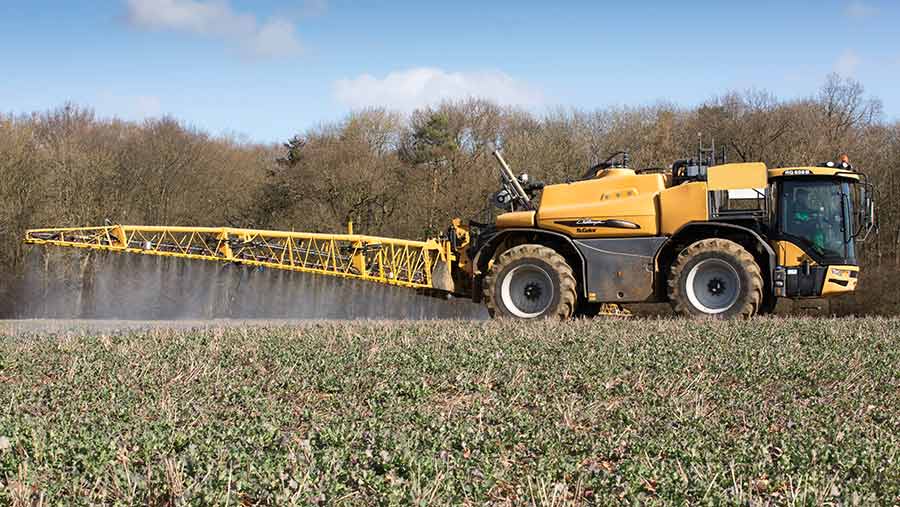Crop Watch: OSR disease concerns and variable weed control
 © Tim Scrivener
© Tim Scrivener Unseasonal conditions have seen good progress with cultivations, spring drilling and fertiliser applications, even in some parts of Scotland. Crops are generally coming out of the winter looking good, especially oilseed rape in non-flea beetle areas.
However, there is some concern with oilseed rape in the West, with an eruption of light leaf spot in the past few days along with signs of a worsening clubroot problem.
In cereals, the effectiveness of autumn pre- and post-emergence herbicides is looking mixed, with big variations in weed control. Two of our agronomists have highlighted umbelliferae weeds (which include wild carrot) that have survived in some crops and will need dealing with this spring.
North: Mary Munro
AICC/Strutt and Parker (Perthshire)

Mary Munro
What a difference a year makes, much of Scotland has had a mild and dry winter. February daytime temperatures have frequently been above 10C and crops have come through the winter looking very well indeed.
Slug activity this winter has been minimal, which is a joy.
A sharp frost in January knocked back the disease levels, but my suspicion is that they could flare up quickly this year. At this stage last year, we were experiencing the Beast from the East and it would be rash to assume that winter is behind us.
This means we have to plan to deal with what’s in front of us, and have a contingency for more “normal” weather featuring precipitation.
Good conditions in East Lothian have allowed many growers to get the first dose of nitrogen on to oilseed rape and barley, and make a start sowing spring beans.
Further north the soils are wetter, and this is not the time to make massive wheel marks as you have to live with them till harvest.
To my mind the rape crops are the most pleasing at this point. Free of slugs and floods, they have retained good plant numbers and leaf area.
Pesky pigeons
Pigeons are a perennial problem in February and March, but temperatures are lifting and the crops are beginning to move. A spray for light leaf spot will be the next action.
Wheats are generally gap-free and tillering. The good tilths and dry winter have enabled excellent root development.
There is the usual low-level septoria in most crops, but with less Leeds in the ground the amount of mildew is greatly reduced.
Last year it was not a difficult decision to omit T0 – this year I am aiming to get it on for all but the most exceptional cases.
The loss of products is becoming a challenge and my faithful Cherokee (chlorothalonil + cyproconazole + propiconazole) is the first casualty this season, so a suitable alternative has to be found that can clean up without costing too much.
The new fungicides coming on stream will be hugely important, and we will have to use them with care to ensure they remain effective for as long as possible. Ditching dirty varieties seems an obvious starting point.
West: Antony Wade
Hillhampton Technical Services (Herefordshire/Shropshire)

Antony Wade
Oilseed rape crops are starting to show signs of stem extension, so those crops that require a spring weed tidy up are a priority for treatment.
Bifenox will be used to try to finish off the remaining charlock, those requiring clopyralid will be done by the time this is printed, to try to meet the ‘before buds visible’ stage.
From other reports in other areas, flea beetle larvae are frequent in crops, but we are lucky and generally not seeing high levels.
Of more concern is the discovery of further clubroot-infected patches in fields not seen previously, continuing the recent increasing occurrence of this disease.
Until recently I wasn’t finding light leaf spot symptoms, but this has erupted in the past seven to 10 days, with confirmed infections in Alibaba, Phoenix and Aquila. Phoma re-infection is also present, so fungicide recommendations based on prothioconazole are being made.
I still have crops with green area indices of 1.5-2, but I am holding back my Caryx (mepiquat + metconazole) until I’m more convinced that we will not get a colder spell of weather as we are only just into March.
Early drilled wheat crops have tillered out well, I have September drilled crops with eight to 10 tillers, with more than adequate numbers to compensate for some swollen tillers from gout fly larvae.
The results of the YEN entries indicate that we need high biomass with high ear numbers, so we will be trying to retain the majority of these tillers.
Little and often
The early start to spring may mean a change to a little and often approach to nitrogen applications and plant growth regulator strategies to assist tiller retention while minimising lodging risk.
The autumn mildew that was prevalent in some of these crops has browned off and looks inactive even after just the few frosts we have had, but will soon liven up with milder temperatures.
Septoria is becoming evident on lower leaves. It is particularly noticeable on varieties such as Grafton and Siskin, but even on more resistant varieties such as Graham.
Winter barleys have tillered equally well, but leaf area has just started to yellow slightly so will be first to receive fertiliser and where required manganese to ensure we do not lose any of those tillers that are critical to maximise yield.
I have fewer hybrid barley crops this season, but those I do have seem to be holding better leaf area than the two-row crops.
All crops have carried a significant mildew burden over winter so T0 applications will ensure this is controlled, along with an early growth regulator.
East: Marion Self
AICC/Prime Agriculture (Suffolk)

Marion Self
Spring has arrived early, with relatively warm temperatures and drying field conditions. It’s difficult to sit still when there is the opportunity to start chipping away at the spring workload.
Growers have started by applying the first nitrogen dressings on oilseed rape, winter barley and late or thinner wheat crops.
Forward, first wheat crops can wait a while longer, especially as available soil nitrogen is likely to be high following the dry, mild winter.
September-drilled wheats and barley (in particular the hybrid varieties) are forward and frothy. Symptomatic manganese deficiencies have been corrected and crop health is improving ahead of treatments for grassweed control.
Field walking has revealed big variations in the success of autumn pre- and post-emergence herbicide treatments. Low, scattered blackgrass populations, sometimes with heavy patches of big plants, are common although later-drilled crops are cleaner.
Heavy autumn treatments have left very low broad-leaved weed populations except in some circumstances for groundsel and umbelliferae species (fools parsley, wild carrot etc).
As normal, winter cereals are carrying plenty of disease inoculum, which until recent days has been kept in check by cool temperatures and frosts. As temperatures rise monitor new growth for fresh pustules of mildew and rusts.
T0 strategy
On wheat, planned T0s will include a dose of an azole with chlorothalonil to start rust and septoria protection.
Keeping the bottom of the canopy clean and well-protected is important, particularly now the eradicant activity of azoles is weak. At this time some crops may need an additional mildewicide.
Barley varieties (including the hybrids) are carrying moderate infections of mildew and brown rust. On barley growers will consider a T0 fungicide with the first plant growth regulator (PGR) application (growth stage 30).
Yield responses to this timing are not guaranteed, but applications can be very useful in delaying the timing of T1 and T2. Without a T0 the time between T1 and T2 can become uncomfortably stretched or the programme requires an additional late spray or ends too early.
Oilseed rape crops are looking well and beginning to grow. Rapeseed sprays based on clopyralid for thistle and mayweed control can be applied from 1 March. Check that forward crops are within the safe growth stage for application (before green buds are raised above the canopy).
Where applied, AstroKerb (propyzamide+ aminopyralid) has already checked these targets and this workload is much reduced. Rapeseeds will receive a light leaf spot/PGR application at green bud.
South: Richard Harding
Procam (Sussex)

Richard Harding
A glorious end to the week here on the Downs has seen significant field work taking place. Despite opportunistic areas of spring barley being drilled in early January, cultivations and drilling has now started in earnest.
Early nitrogen is being applied to more backward or late-drilled wheat crops. Sulphur/nitrogen blends are also being applied to oilseed rape crops, which have generally come through the winter unscathed.
The first real pigeon grazing has taken place in the past few weeks. Oilseed rape crops established with a mix of companions appears to be an effective way of deterring the pigeons for longer than straight OSR.
Here it is the linseed element of the companion, which was chosen for this purpose.
Cabbage stem flea beetle are at very variable levels in crops within the local area. Only temperatures below 3C may slow egg and larval development so recent mild weather is not helping.
There is some evidence from ADAS trials that pyrethroids can be effective into February, but it isn’t clear if resistance to pyrethroids in adult cabbage stem flea beetle is conferred to the larvae.
Treatment will be considered where thresholds are five larvae per plant or 50% of petioles with leaf scarring.
Phoma re-infection is now easy to spot in some OSR crops, but the focus now will be on light leaf spot. There is no threshold for the disease prior to stem extension, so a mix of tebuconazole and prothioconazole will be applied at the first signs of the disease.
Weed survivors
Generally, autumn residual herbicides have performed well, but there are fields where control has “fallen short”. Depending on whether resistance is confirmed, now is the time to make decisions on whether to treat these areas of grassweeds or remove them.
Depending on the soil type and herbicides applied, there are several options available for establishing a spring crop.
As is often quoted, even relatively low populations of 10 blackgrass/sq m can produce on average 10 tillers per plant (often more) and 100 seeds per head, resulting in 10,000 seeds/sq m seed return. With seed production being higher in thinner crops.
Unpalatable though it might be, glyphosate may give better long-term control where herbicide resistance to mesosulfuron + iodosulfuron has been confirmed.
Although much focus is on grassweeds, some troublesome broad-leaved weed populations will require attention. Some umbellifers have not succumbed fully to the autumn residuals.
Combinations of sulfonylurea herbicides with florasulam or Arylex/florasulam options will be considered with the more favourable conditions we now have, although weed size is already “challenging” in some situations.

